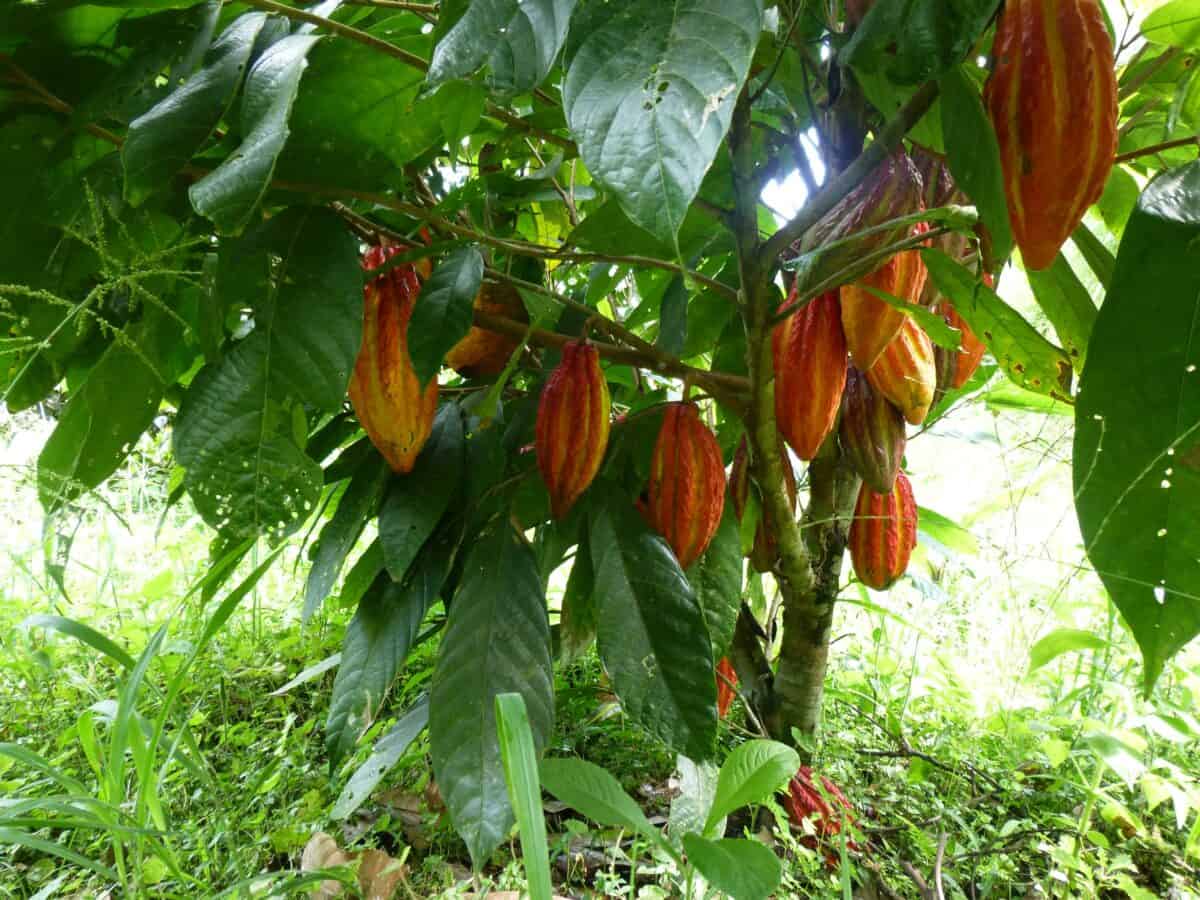This article was compiled by Briana Hilton and edited by Max Gandy.
Agroforestry-style growth is a farming approach that thoughtfully integrates native trees, shrubs, and other perennial vegetation with commercial agricultural crops. It has the power to transform cocoa cultivation in Malaysia by improving yields and overall quality, while normalizing sustainable farming practices.
In addressing the multifaceted challenges faced in cocoa cultivation — namely, loss of biodiversity, soil degradation, climate change, and even forced labor — agroforestry offers a holistic solution for Malaysian farmers.
Proponents claim that it helps with creating more biodiverse ecosystems, enhancing soil fertility, and providing climate resilience. However education, training, and support programs are essential to empower Malaysian farmers with the knowledge and skills needed to adopt and sustain such practice.

Jump to:
Improving Cocoa Productivity
In agroforestry systems, cocoa plants thrive in harmony with so-called companion plants, creating in a mutually beneficial relationship that enhances overall productivity. For instance, nitrogen-fixing legumes such as petai and soybeans are often intercropped with cocoa.
These legumes have specialized root nodules containing nitrogen-fixing bacteria that convert atmospheric nitrogen into a form usable by plants. As a result, they replenish soil fertility, enriching it with essential nutrients like nitrogen, eliminating the need for synthetic fertilizers.
Additionally, shade-providing trees like rambutan or tualang help regulate temperature and create favorable microclimates for cocoa growth. These trees form a natural canopy that filters sunlight, preventing excessive heat stress on cocoa plants during the hottest parts of the day and protecting them from sunburn.
This temperature control fosters optimal conditions for cocoa development, promoting healthy growth and higher year-round yields. Moreover, agroforestry systems also offer natural pest and disease management benefits, reducing a farm's reliance on chemical interventions.
For instance, companion plants like marigolds and lemongrass are known for their pest-repellent properties. By intercropping these plants with cocoa, farmers can effectively deter unwanted pests like aphids and mealybugs, reducing crop damage and yield losses without costly chemicals.

Superior Flavor and Quality
Agroforestry practices can also positively influence cocoa bean quality through strategic use of shaded environments and aromatic compounds from companion plants.
As cocoa beans are grown under the shade of such companion trees, the maturation process is slowed down and fermentation extended, facilitating the development of rich, complex flavors over a longer period.
Additionally, companion plants introduce aromatic compounds and phytochemicals that are thought to enhance cocoa flavor profiles.
For instance, aromatic flowers like those of the tembusu tree release fragrances that infuse the surrounding environment, potentially imparting subtle floral notes to cocoa beans during growth and then fermentation.

Wildlife Diversity and Habitat Creation
By supporting various trees, shrubs, vines, and other vegetation alongside cocoa plants, agroforestry mimics the higher level of diversity found in comparable ecosystems that are undisturbed, providing habitat and sustenance for native flora and fauna.
“Agroforestry improves floral, faunal, and soil microbial diversity compared to monocropping,” a recent study entitled Agroforestry for Biodiversity Conservation found.
For example, in Malaysia, planting endangered medicinal plants like Tongkat Ali and Kacip Fatimah alongside cocoa trees not only safeguards threatened species but also creates microhabitats that support a wide range of wildlife.
To extend the lifespan of plants and shrubs in agroforestry systems, regular pruning is particularly essential. Pruning helps maintain the health and structure of plants, promoting new growth and preventing disease or overcrowding.

Forging Pathways to Sustainable Cocoa Agriculture
While the potential of agroforestry for cocoa cultivation in Malaysia is vast, especially on the islands of Sabah, knowledge gaps among farmers regarding agroforestry techniques and species selection mean adoption has yet to become widespread.
This knowledge gap isn't localized to Malaysia, however; from my experience, cacao farmers around the world more commonly introduce cacao in a monocrop environment rather than the wild harvest of agroforestry approaches.
Targeted capacity-building initiatives and extension services — led by governmental organizations, NGOs, or industry partnerships — are crucial for educating and training farmers in sustainable farming practices, agroforestry techniques, and biodiversity conservation.
Notably, the Nestle Borneo Cocoa Initiative (NBCI) exemplifies a proactive approach towards bridging these gaps and promoting sustainable cocoa farming practices.
Through the NBCI, Malaysian farmers are being provided with training and resources on agroforestry methods like growing compatible plants such as palm oil or rubber trees, as well as crops like petai and durian, alongside cocoa (though on a personal level, I've never seen happy cocoa trees growing alongside rubber trees).
This diversification not only enhances farm resilience but also provides additional seasonal income streams for farmers. Agroforestry holds great promise for growing cocoa in Malaysia, offering a sustainable approach that improves biodiversity, productivity, and revenue.
By integrating diverse plant species and fostering ecosystem resilience, agroforestry not only ensures the long-term viability of cocoa farming, but also contributes to environmental conservation and more economic prosperity in the country’s cocoa-producing regions.

















Comments
No Comments